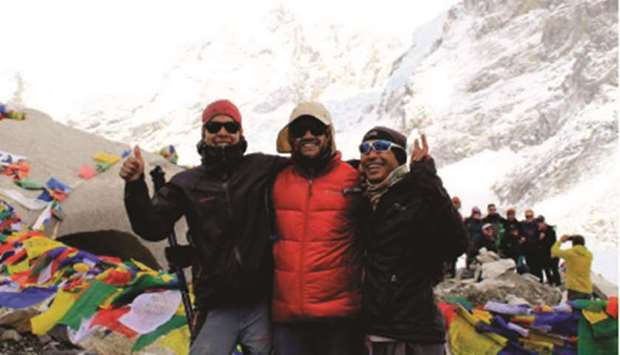The struggles in life become sweet if we have a purpose. Accomplishing small goals while keeping your eyes set on a bigger purpose makes the struggles of life sweet and steady.
The life-long struggle of 42-year-old Abdul Nassar has been marked with exemplary accomplishments. It is a story about a journey from abject poverty, through desolate orphanage to educational excellence, an enviable career path and inspirational achievements.
Nassar, an Indian expatriate and a chartered accountant by profession, is going to surmount the highest peak of the world – Mount Everest. He believes that he is going to be the first Indian living in Qatar and first ever chartered accountant attempting to ascent the mount.
An ardent athlete, Nassar is also a marathon runner, writer, and a motivational speaker. Son of a prayer leader in Kerala, he has been working in the oil and gas sector in Qatar since 2007.
While talking to Community, before leaving for Nepal, he said that he was going to take the attempt as the next challenge in his life. He has already taken part in Ironman Race in Malaysia and different marathons around the world including Qatar. He has also written an inspirational book motivating people to try and materialise their dreams.
“I am also an advocate for girls’ education. I am taking up the challenge only to make my three daughters proud. I want to show them that with dedication and hard work, everything can be achieved,” said Nassar, who will land in Nepal on April 16 after a short visit to India.
About the expedition, he said: “I had tasted a little bit of the mountain experience when I summited 12,763 feet high Kuwari Pass, Himalaya, from Utharaknad, India in 2015. A guide aptly said that there are two types of people he has come across. There are people who never come back after their first experience and those who keep coming back, falling in love with mountains on their first visit. Then I realised that I belong to the second group.”
He returned to the mountains for the second time on April 19, 2018, trekking to Everest Base Camp (17,600 feet). “I sighted Everest closely from Kaala Pathar Mountain Peak (18,519 feet) at sunrise. I decided to return and conquer the majestic mountain.”
Explaining the expedition itinerary, the mountaineer said: “I will leave Doha for India April 12 (today). I will land in Nepal on April 16 to join the expedition team Seven Summit Treks PLTD, comprising of 26 international climbers, hailing from India, Spain, Italy, USA, Australia and UK.
“The duration of the expedition will be 60 days. The maximum altitude is 8,848 metre or 29,029 feet. We will be walking for five to seven hours every day. We will depart from Kathmandu on April 18.”
Nassar will take the southern route to the summit. “This trip suits those who have previous experiences of few 7,000m peaks or even more. The real trek apparently starts from the base camp and to reach the base camp takes you around seven days on foot. Then we will move on to the camp I (6,065m) where we will see Khumbu Glacier. From Khumbu Glacier, we will cover around 450m on a gradual slope to reach Camp II (6,750m) and then will cover around 610m to be at Camp III (7,100m). Camp III is located at the head of Lhotse. From this point onwards, we will need oxygen cylinders. We will reach the Camp IV (7,910m) after crossing 8,000m elevations. This point is also known as the Death Zone.
“Mount Everest expedition is undoubtedly a lifetime opportunity. Nevertheless, these expeditions encounter many hindrances such as high altitude, severe weather conditions and avalanches. One must be well trained before actually trying it. You need to get your body ready for the 8,848m climb to the Everest’s summit. Depending on your current level of fitness, you need to train for several months before you start your ascent. A climber must build his/her cardiovascular strength along with muscular strength. Oxygen level drops by 60-70 percent from sea level. Also make sure you can carry big bag packs to top as you will be carrying cylinder of oxygen and large bag packs along with you. One must acclimatise with weather conditions and be prepared for rock falls, avalanches. Learning rescue techniques would be added advantages.”

BASE CAMP: Nassar at the Everest Base Camp with friends.


